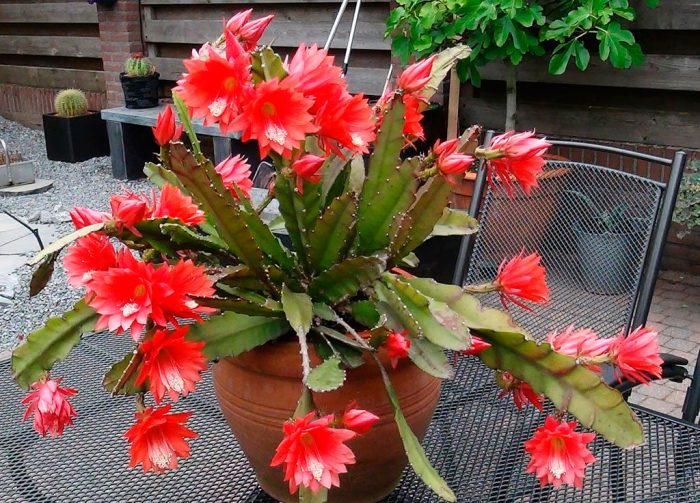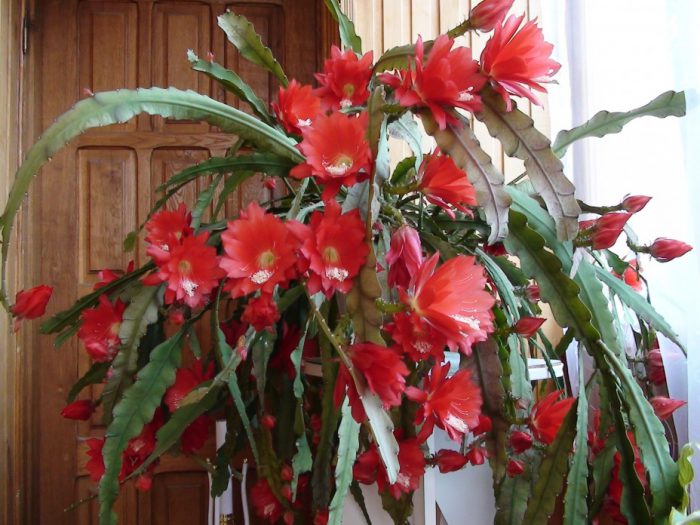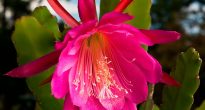A plant like epiphyllum is directly related to the cactus family. Under natural conditions, this plant can be found in tropical America, as well as in Mexico. Often, epiphyllums are also called phyllocactus, which means "leafy cactus". This genus unites almost 20 plant species, represented by epiphytes and semi-shrubs with a leaf-shaped stem and a lignified base. Epiphyllum has no foliage; instead, there are flat and rather wide shoots. Skeletal branches can be triangular or rounded. This plant is highly branching and fast-growing. Young shoots are directed vertically upwards, but over time, they droop. Because of their large, spectacular flowers, such plants are also called "orchid cacti" by botanists. The first time a cactus blooms at the age of three. Quite large flowers can be up to 30 centimeters long and up to 15 centimeters in diameter. The flowers are funnel-shaped and have a long flower tube. There are species whose fragrant flowers have a rather pleasant aroma.
At the moment, there are more than 10,000 varieties of such a plant, thanks to the efforts of flower growers.
Content
Main types
Epiphyllum Ackermann (Epiphyllum ackermannii)
It is a hybrid plant that has flowers painted in a satin deep red color. This cactus is the most unpretentious of all the species in this genus.
Epiphyllum oxypetalum (Epiphyllum oxypetalum)
This species is natural. The shoots of such a plant grow up to 200 centimeters long and 12 centimeters wide. The blooming of snow-white fragrant flowers occurs at night.
Home epiphyllum care
Illumination
They love light very much. For placement, you must choose well-lit places, but at the same time protected from direct sunlight (otherwise, a burn may appear on the shoots).
Temperature regime
Heat resistant. In winter, moderate temperatures are recommended, ranging from 15 to 20 degrees. It should be noted that the room where the epiphyllum is located should not be colder than 10 degrees, otherwise it may die.
How to water
Watering should be moderate, and the accumulated liquid must be poured out of the pan. In winter, watering is carried out only after the substrate is completely dry.
Air humidity
For normal growth and development of the plant, high humidity is required.It is recommended to carry out systematic spraying of the shoots, as well as their washing (for this, a jet of water at room temperature is used).
Transplant features
The plant needs to be transplanted once a year, systematic pruning is carried out. In this case, shoots that are damaged, ugly or old, as well as those on which flower buds are not laid, are subject to pruning.
Reproduction methods
You can propagate it by stem cuttings. This procedure is carried out in the spring and autumn. To do this, cut off the lateral shoots and sharpen the end just above the narrow part of the stem (wedge-shaped). The stalk is placed vertically and left in the open air for 5 or 6 days to dry. For cuttings, you need to choose shoots older than 1 year, but lignified old ones are also not suitable. Root formation occurs very quickly, while water or a moistened substrate is used for rooting.
Possible difficulties
- An adult cactus does not bloom - improper care provided. Transplant and systematically feed the plant.
- The plant sheds buds - the conditions in which the epiphyllum is contained have changed dramatically. We have to wait while he adapts.














